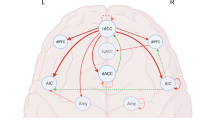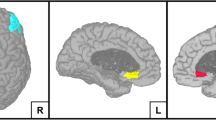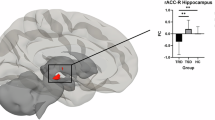Abstract
Anterior cingulate cortex (ACC) response during attentional control in the context of task-irrelevant emotional faces is a promising biomarker of cognitive behavioral therapy (CBT) outcome in patients with social anxiety disorder (SAD). However, it is unclear whether this biomarker extends to major depressive disorder (MDD) and is specific to CBT outcome. In the current study, 72 unmedicated patients with SAD (n = 39) or MDD (n = 33) completed a validated emotional interference paradigm during functional magnetic resonance imaging before treatment. Participants viewed letter strings superimposed on task-irrelevant threat and neutral faces under low perceptual load (high interference) and high perceptual load (low interference). Biomarkers comprised anatomy-based rostral ACC (rACC) and dorsal ACC (dACC) response to task-irrelevant threat (>neutral) faces under low and high perceptual load. Patients were randomly assigned to 12 weeks of CBT or supportive therapy (ST) (ClinicalTrials.gov identifier: NCT03175068). Clinician-administered measures of social anxiety and depression severity were obtained at baseline and every 2 weeks throughout treatment (7 assessments total) by an assessor blinded to the treatment arm. A composite symptom severity score was submitted to latent growth curve models. Results showed more baseline rACC activity to task-irrelevant threat>neutral faces under low, but not high, perceptual load predicted steeper trajectories of symptom improvement throughout CBT or ST. Post-hoc analyses indicated this effect was driven by subgenual ACC (sgACC) activation. Findings indicate ACC activity during attentional control may be a transdiagnostic neural predictor of general psychotherapy outcome.
Similar content being viewed by others
Log in or create a free account to read this content
Gain free access to this article, as well as selected content from this journal and more on nature.com
or
References
Wittchen HU, Jacobi F, Rehm J, Gustavsson A, Svensson M, Jönsson B, et al. The size and burden of mental disorders and other disorders of the brain in Europe 2010. Eur Neuropsychopharmacol. 2011;21:655–79.
David D, Cristea I, Hofmann SG. Why cognitive behavioral therapy is the current gold standard of psychotherapy. Front Psychiatry. 2018;9:4.
Springer KS, Levy HC, Tolin DF. Remission in CBT for adult anxiety disorders: A meta-analysis. Clin Psychol Rev. 2018;61:1–8.
Hollon SD, Thase ME, Markowitz JC. Treatment and prevention of depression. Psychol Sci Public Interest. 2002;3:39–77.
Cuijpers P, Cristea IA, Karyotaki E, Reijnders M, Huibers MJH. How effective are cognitive behavior therapies for major depression and anxiety disorders? A meta-analytic update of the evidence. World Psychiatry. 2016;15:245–58.
Koole SL, Rothermund K. ‘I feel better but I don’t know why’: The psychology of implicit emotion regulation. Cogn Emot. 2011;25:389–99.
Peckham AD, McHugh RK, Otto MW. A meta-analysis of the magnitude of biased attention in depression. Depress Anxiety. 2010;27:1135–42.
Bögels SM, Mansell W. Attention processes in the maintenance and treatment of social phobia: Hypervigilance, avoidance and self-focused attention. Clin Psychol Rev. 2004;24:827–56.
Arch JJ, Craske MG. First-line treatment: A critical appraisal of cognitive behavioral therapy developments and alternatives. Psychiatr Clin North Am. 2009;32:525–47.
DeRubeis RJ, Siegle GJ, Hollon SD. Cognitive therapy versus medication for depression: Treatment outcomes and neural mechanisms. Nat Rev Neurosci. 2008;9:788–96.
Etkin A, Egner T, Kalisch R. Emotional processing in anterior cingulate and medial prefrontal cortex. Trends Cogn Sci. 2011;15:85–93.
Stevens FL, Hurley RA, Taber KH. Anterior cingulate cortex: Unique role in cognition and emotion. J Neuropsychiatry Clin Neurosci. 2011;23:121–5.
Kanske P, Kotz SA. Emotion speeds up conflict resolution: A new role for the ventral anterior cingulate cortex? Cereb Cortex. 2011;21:911–9.
Klumpp H, Fitzgerald DA, Angstadt M, Post D, Phan KL. Neural response during attentional control and emotion processing predicts improvement after cognitive behavioral therapy in generalized social anxiety disorder. Psychol Med. 2014;44:3109–21.
Klumpp H, Fitzgerald DA, Piejko K, Roberts J, Kennedy AE, Phan KL. Prefrontal control and predictors of cognitive behavioral therapy response in social anxiety disorder. Soc Cogn Affect Neurosci. 2016;11:630–40.
Frick A, Engman J, Alaie I, Björkstrand J, Gingnell M, Larsson EM, et al. Neuroimaging, genetic, clinical, and demographic predictors of treatment response in patients with social anxiety disorder. J Affect Disord. 2020;261:230–7.
Pizzagalli DA. Frontocingulate dysfunction in depression: Toward biomarkers of treatment response. Neuropsychopharmacology. 2011;36:183–206.
Fu CHY, Steiner H, Costafreda SG. Predictive neural biomarkers of clinical response in depression: A meta-analysis of functional and structural neuroimaging studies of pharmacological and psychological therapies. Neurobiol Dis. 2013;52:75–83.
Mayberg HS, Brannan SK, Mahurin RK, Jerabek PA, Brickman JS, Tekell JL, et al. Cingulate function in depression: A potential predictor of treatment response. Neuroreport. 1997;8:1057–61.
Ebert D, Feistel H, Barocka A, Kaschka W. Increased limbic blood flow and total sleep deprivation in major depression with melancholia. Psychiatry Res Neuroimaging. 1994;55:101–9.
Langguth B, Wiegand R, Kharraz A, Landgrebe M, Marienhagen J, Frick U, et al. Pre-treatment anterior cingulate activity as a predictor of antidepressant response to repetitive transcranial magnetic stimulation (rTMS). Neuroendocrinol Lett. 2007;28:633–8.
Fu CHY, Williams SCR, Cleare AJ, Scott J, Mitterschiffthaler MT, Walsh ND, et al. Neural responses to sad facial expressions in major depression following cognitive behavioral therapy. Biol Psychiatry. 2008;64:505–12.
Palomero-Gallagher N, Mohlberg H, Zilles K, Vogt B. Cytology and receptor architecture of human anterior cingulate cortex. J Comp Neurol. 2008;508:906–26.
McGrath CL, Kelley ME, Dunlop BW, Holtzheimer PEH, Craighead WE, Mayberg HS. Pretreatment brain states identify likely nonresponse to standard treatments for depression. Biol Psychiatry. 2014;76:527–35.
Konarski JZ, Kennedy SH, Segal ZV, Lau MA, Bieling PJ, McIntyre RS, et al. Predictors of nonresponse to cognitive behavioural therapy or venlafaxine using glucose metabolism in major depressive disorder. J Psychiatry Neurosci. 2009;34:175.
Siegle GJ, Carter CS, Thase ME. Use of fMRI to predict recovery from unipolar depression with cognitive behavior therapy. Am J Psychiatry. 2006;163:735–8.
Siegle GJ, Thompson WK, Collier A, Berman SR, Feldmiller J, Thase ME, et al. Toward clinically useful neuroimaging in depression treatment: Prognostic utility of subgenual cingulate activity for determining depression outcome in cognitive therapy across studies, scanners, and patient characteristics. Arch Gen Psychiatry. 2012;69:913–24.
Northoff G, Heinzel A, de Greck M, Bermpohl F, Dobrowolny H, Panksepp J. Self-referential processing in our brain—A meta-analysis of imaging studies on the self. Neuroimage. 2006;31:440–57.
Phillips ML, Drevets WC, Rauch SL, Lane R. Neurobiology of emotion perception I: The neural basis of normal emotion perception. Biol Psychiatry. 2003;54:504–14.
Broadbent DE. Perception and communication. New York: Pergamon Press; 1958.
Pashler H. Dual-task interference in simple tasks: Data and theory. Psychol Bull. 1994;116:220–44.
Lavie N, Hirst A, De Fockert JW, Viding E. Load theory of selective attention and cognitive control. J Exp Psychol Gen. 2004;133:339–54.
Bishop SJ, Jenkins R, Lawrence AD. Neural processing of fearful faces: Effects of anxiety are gated by perceptual capacity limitations. Cereb Cortex. 2007;17:1595–603.
Bunford N, Roberts J, Kennedy AE, Klumpp H. Neurofunctional correlates of behavioral inhibition system sensitivity during attentional control are modulated by perceptual load. Biol Psychol. 2017;127:10–7.
Klumpp H, Kinney KL, Kennedy AE, Shankman SA, Langenecker SA, Kumar A, et al. Trait attentional control modulates neurofunctional response to threat distractors in anxiety and depression. J Psychiatr Res. 2018;102:87–95.
Wampold BE. How important are the common factors in psychotherapy? An update. World Psychiatry. 2015;14:270–7.
Chu BC, Skriner LC, Zandberg LJ. Shape of change in cognitive behavioral therapy for youth anxiety: Symptom trajectory and predictors of change. J Consult Clin Psychol. 2013;81:573–87.
Andrews LA, Hayes AM, Abel A, Kuyken W. Sudden gains and patterns of symptom change in cognitive-behavioral therapy for treatment-resistant depression. J Consult Clin Psychol. 2020;88:106–18.
Liebowitz MR. Social phobia. Mod Probl Pharmacopsychiatry. 1987;22:141–73.
Hamilton M. A rating scale for depression. J Neurol Neurosurg Psychiatry. 1960;23:56–62.
Beck AT, Steer RA, Brown GK. Manual for the Beck depression inventory-II. Psychological Corporation: San Antonio, TX; 1996.
First MB, Williams JBW, Karg RS, Spitzer RL. Structured clinical interview for DSM-5—Research version (SCID-5 for DSM-5, research version; SCID-5-RV). Arlington, VA: American Psychiatric Association; 2015.
Beck AT, Rush AJ, Shaw BF, Emery G. Cognitive therapy of depression. Guilford Press: New York; 1979.
Hope DA, Heimberg RG, Turk CL. Managing social anxiety: A cognitive-behavioral therapy approach. Oxford University Press: New York; 2006.
Martell CR, Dimidjian S, Herman-Dunn R. Behavioral activation for depression: A clinician’s guide. Guilford Press: New York; 2010.
Markowitz JC, Manber R, Rosen P. Therapists’ responses to training in brief supportive psychotherapy. Am J Psychother. 2008;62:67–81.
Rogers CR. Significant aspects of client-centered therapy. Am Psychol. 1946;1:415–22.
Moeller J. A word on standardization in longitudinal studies: Don’t. Front Psychol. 2015;6:1389.
Kuckertz JM, Najmi S, Baer K, Amir N. Refining the analysis of mechanism–outcome relationships for anxiety treatment: a preliminary investigation using mixed models. Behav Modif. April. https://doi.org/10.1177/0145445519841055.
Asnaani A, Benhamou K, Kaczkurkin AN, Turk-Karan E, Foa EB. Beyond the constraints of an RCT: Naturalistic treatment outcomes for anxiety-related disorders. Behav Ther. 2020;51:434–46.
Little TD. Longitudinal structural equation modeling. New York, NY: Guilford Press; 2013.
Ekman P, Friesen WV. Pictures of facial affect. Consult Psychol Press: Palo Alto, CA; 1976.
Rolls ET, Huang CC, Lin CP, Feng J, Joliot M. Automated anatomical labelling atlas 3. Neuroimage 2020;206:116189.
Brett M, Anton JL, Valabregue R, Poline JB. Region of interest analysis using an SPM toolbox. Present. 8th Int. Conferance Funct. Mapp. Hum. Brain, 2002.
Gorka SM, Young CB, Klumpp H, Kennedy AE, Francis J, Ajilore O, et al. Emotion-based brain mechanisms and predictors for SSRI and CBT treatment of anxiety and depression: A randomized trial. Neuropsychopharmacology. 2019;44:1639–48.
Yang Z, Oathes D, Linn KA, Bruce SE, Satterthwaite TD, Cook PA, et al. Cognitive behavioral therapy is associated with enhanced cognitive control network activity in major depression and posttraumatic stress disorder. Biol Psychiatry Cogn Neurosci Neuroimaging. 2018;3:311–9.
Etkin A, Egner T, Peraza DM, Kandel ER, Hirsch J. Resolving emotional conflict: A role for the rostral anterior cingulate cortex in modulating activity in the amygdala. Neuron. 2006;51:871–82.
Tolin DF. Is cognitive-behavioral therapy more effective than other therapies? A meta-analytic review. Clin Psychol Rev. 2010;30:710–20.
Van Dis EAM, Van Veen SC, Hagenaars MA, Batelaan NM, Bockting CLH, Van Den Heuvel RM, et al. Long-term outcomes of cognitive behavioral therapy for anxiety-related disorders: A systematic review and meta-analysis. JAMA Psychiatry. 2020;77:265–73.
Karyotaki E, Smit Y, De Beurs DP, Henningsen KH, Robays J, Huibers MJH, et al. The long-term efficacy of acute-phase psychotherapy for depression: A meta-analysis of randomized trials. Depress Anxiety. 2016;33:370–83.
Cuijpers P, Reijnders M, Huibers MJH. The role of common factors in psychotherapy outcomes. Annu Rev Clin Psychol. 2019;15:207–31.
Filkowski MM, Haas BW. Rethinking the use of neutral faces as a baseline in fMRI neuroimaging studies of axis-I psychiatric disorders. J Neuroimaging. 2017;27:281–91.
Funding
This work was supported by NIH/NIMH R01-MH112705 (HK), NIH/NIMH T32-MH067631 (CF), and the Center for Clinical and Translational Research (CCTS) UL1RR029879.
Author information
Authors and Affiliations
Contributions
CF contributed to data analysis, manuscript writing, and interpretation of results. JJ contributed to the collection and analysis of neuroimaging data. RB assisted with the analytic approach. JD performed psychotherapy and contributed to manśuscript preparation. GRM performed psychotherapy and contributed to manuscript preparation. OA reviewed the medical history of patients and contributed to manuscript preparation. SAS contributed to the interpretation of findings and manuscript preparation. SAL contributed to the interpretation of findings and manuscript preparation. MGC oversaw treatment fidelity, adherence, and manuscript preparation. KLP contributed to the interpretation of findings and manuscript preparation. HK contributed to study conception, manuscript writing, and interpretation of results. All authors contributed to and approved the final manuscript.
Corresponding author
Ethics declarations
Competing interests
The authors declare no competing interests.
Additional information
Publisher’s note Springer Nature remains neutral with regard to jurisdictional claims in published maps and institutional affiliations.
Supplementary information
Rights and permissions
About this article
Cite this article
Feurer, C., Jimmy, J., Bhaumik, R. et al. Anterior cingulate cortex activation during attentional control as a transdiagnostic marker of psychotherapy response: a randomized clinical trial. Neuropsychopharmacol. 47, 1350–1357 (2022). https://doi.org/10.1038/s41386-021-01211-2
Received:
Revised:
Accepted:
Published:
Issue date:
DOI: https://doi.org/10.1038/s41386-021-01211-2
This article is cited by
-
Mapping Brain-Wide Neural Activity of Murine Attentional Processing in the Five-Choice Serial Reaction Time Task
Neuroscience Bulletin (2025)



